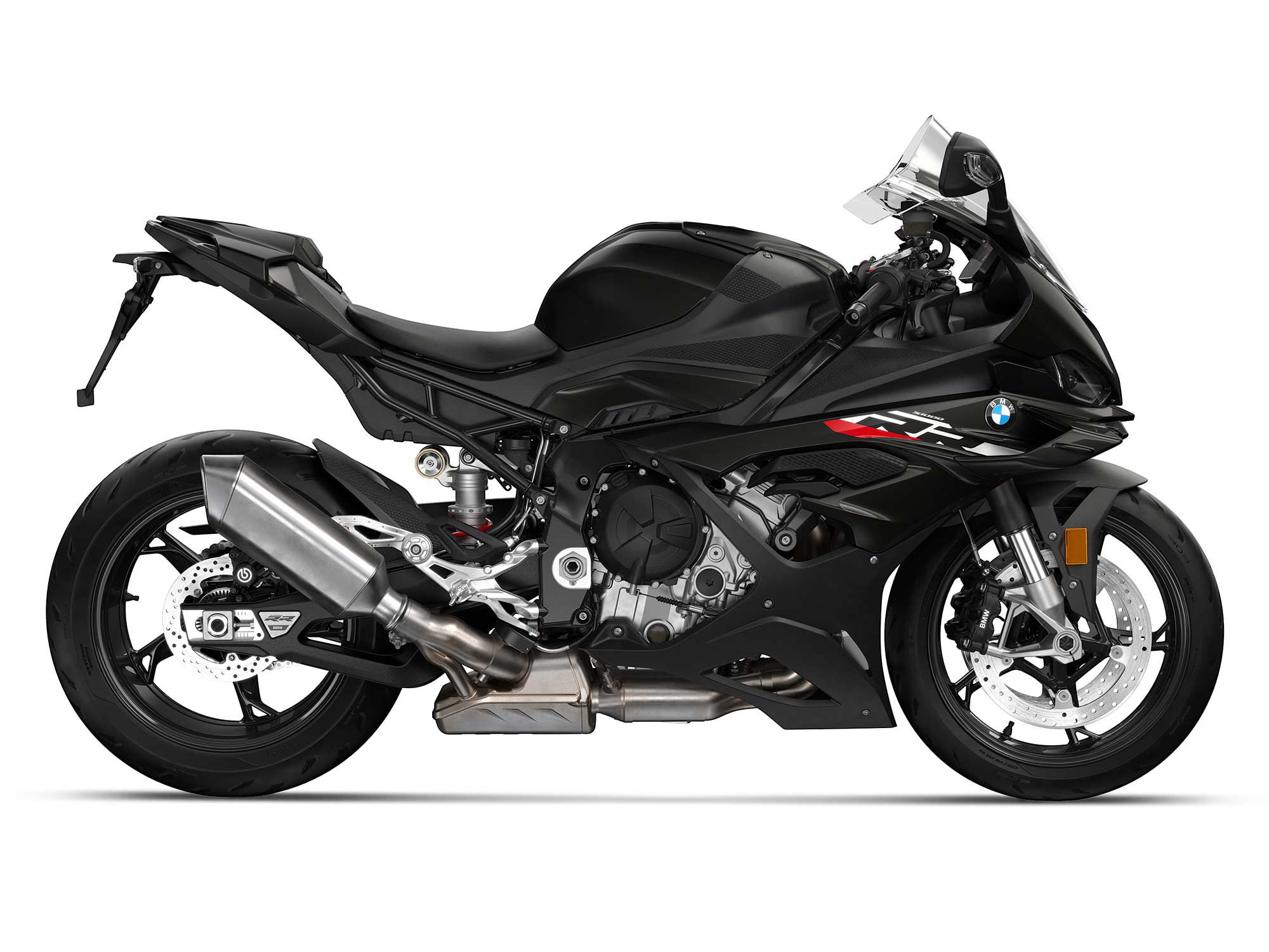
Ups
- Advanced aerodynamics package
- Enhanced electronic rider aids
- Balanced, planted chassis
Downs
- Power restrictions in US trim
- Want the M Package in black? Sorry, no can do.
- Premium Package required for Ride Modes Pro
- Costs increase with each package upgrade
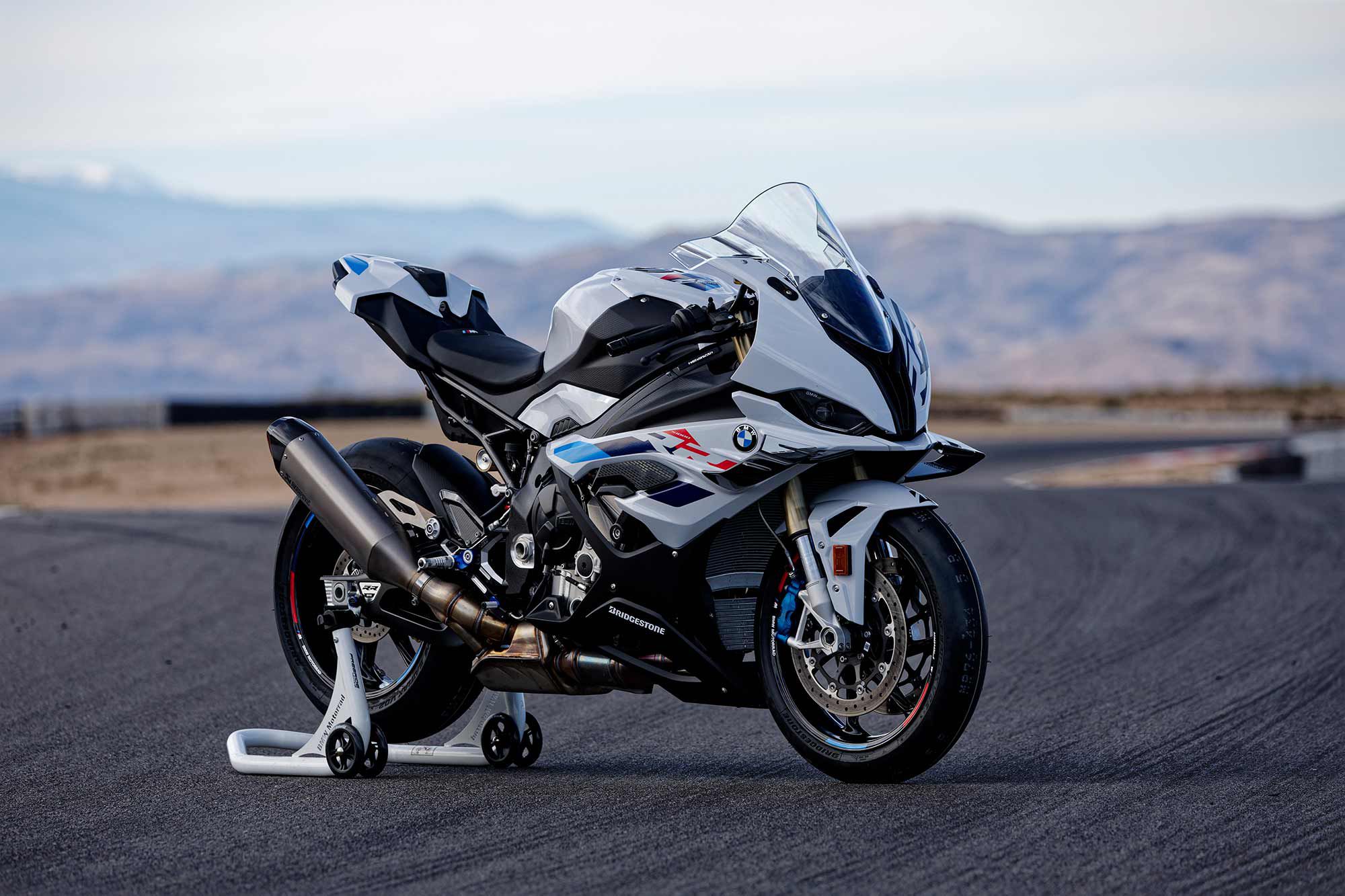
Verdict
Buyers shopping for a track-ready, inline-four-powered sportbike with a ton of features, every electronic bell and whistle in the book, and a chassis with premium components have to consider the S 1000 RR. Combine superb on-track performance with a surprisingly accomodating rider triangle and you have a superbike that’s equally capable on the street or track.
Overview
BMW’s S 1000 RR has been at the forefront of the superbike category since bursting onto the scene in 2009, and despite competition from a variety of open-class models, constant refinement has kept BMW near the front. The bike is popularly known for its stable chassis, potent inline-four engine, and expansive suite of electronic rider aids.
The latter is important to consider, as BMW prides itself on offering the most advanced electronics package for a mass-produced sportbike. The company worked diligently to refine the systems, enabling riders to go faster, and be safer, through modern ABS, traction control, engine-brake, and more. Available Dynamic Damping Control makes setting the bike up for the track that much easier, while enabling it to work well in varying conditions.
Race results might now always prove how capable the bike is, but rest assured, this is one of the most potent superbikes currently available.
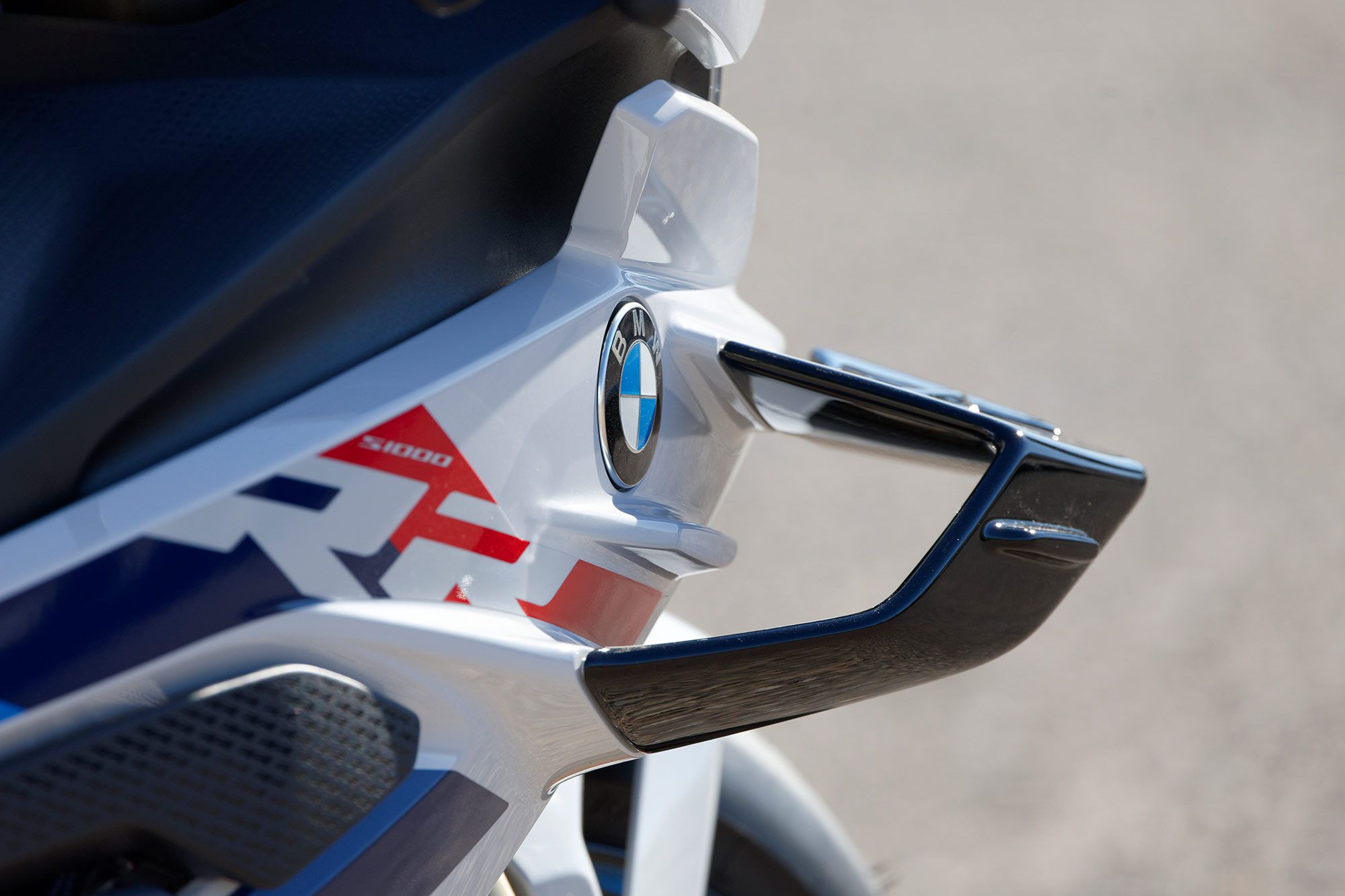
Updates for 2023
The 2023 S 1000 RR borrows much of its technology from the up-spec M 1000 RR, while still managing costs and expectations of a “base model.”
M 1000 RR–inspired winglets are the first thing you’ll notice, this latest design offering up to 22 pounds of front-end downforce at high speed. Further back, and perhaps less obvious, is a tailsection with less bodywork than earlier models, the current design giving the impression that the bike’s mass is packed around its front wheel.
The frame uses the same general layout as before, but BMW added more holes in the four die-cast alloy members that make up the chassis, allowing it to flex more than the previous version. The geometry is also new, with a 0.5-degree decrease in steering-head angle, now set at 23.6 degrees rather than 23.1 degrees. Alongside new triple clamps with 3mm less offset, the change increases trail from 3.7 inches to 3.9 inches and stretches the wheelbase from 56.7 inches to 57.4.
The adjustable swingarm pivot previously found on the M Chassis Kit is standard for 2023, allowing more range to tune the chassis to rider tastes, while a height-adjustable linkage for the shock has been added. Additional changes include a one-tooth-larger, 46-tooth rear sprocket that reduces the final drive ratio and improves acceleration.
US-bound S 1000 RR’s are claimed to make the same power as before, but do have some changes. Intake port geometry is based on the M 1000 RR, there’s a new airbox, and the variable-height intake funnels are shortened.
Key electronic updates include the addition of a Slide Control function, BMW’s new steering-angle sensor feeding information to the traction-control system and allowing it to estimate the drift angle of the bike. Brake Slide Assist has also been added to ABS Pro, and enables the rear wheel to step further out under braking. Shift Assistant Pro has been updated for improved shifts, and other small changes have been incorporated, like the move to a lightweight battery and new wiring harness that makes it easier to remove the license plate bracket.
There’s a little bit of caveat with the color choices on the 2023 S 1000 RR, as not all are available with all the packages that you may want to upgrade to. If you really want the M Package, the only option is to get the bike in the M Motorsport red, white, and blues (yes two shades). If you want the Style Passion Red or Black Storm Metallic paint, you’ll have to add some of the accessories and features piecemeal. For instance, if you want the carbon fiber wheels, that option doesn’t exist outside of the M Package and you’ll have to take the forged-aluminum units. But that’s pretty much the one option you can’t get separately.
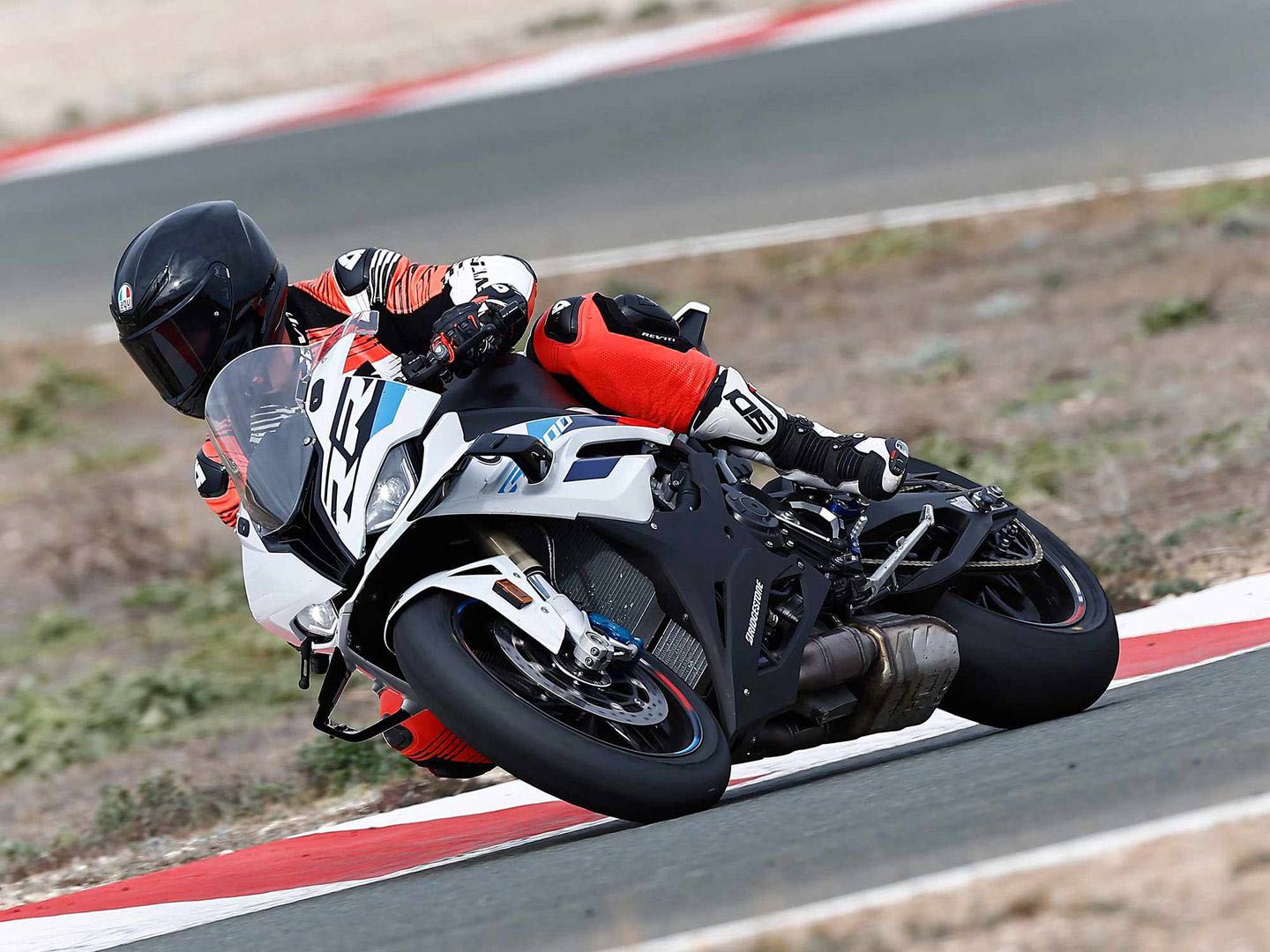
Pricing and Variants
The base-model S 1000 RR is available in Black Storm Metallic for $17,895 and Style Passion Red for $18,270, plus destination and handling fees. There’s more to the story, however, as BMW offers three separate packages for potential customers, and each adds to the price tag.
BMW’s M Package adds $4,495 and includes the following: M paintwork, M footrest system, black fuel filler cap, M Carbon wheels with M tapes, M lettering and new clear coat, and M sports seat. As an alternative to the M Carbon wheels, the customer can also choose the M forged wheels.
The Premium Package is another $2,340 and includes: M Titanium Exhaust System, heated grips, M Endurance Chain, Cruise Control, Ride Modes Pro, and Dynamic Damping Control.
Finally, BMW’s Carbon Package adds a handful of stylish, lightweight bits for an additional $1,995.
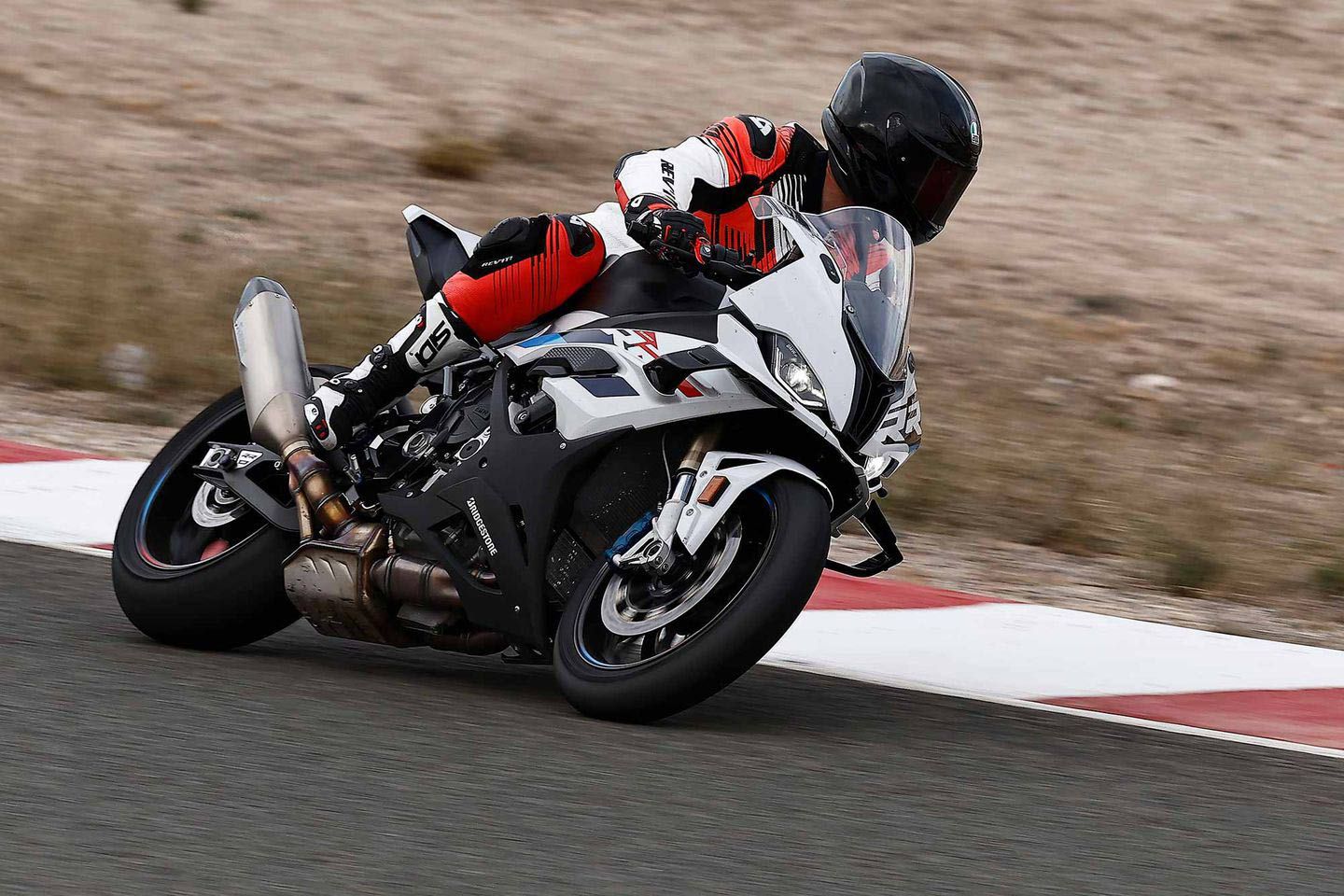
Competition
BMW might be at the forefront of the superbike category, but that doesn’t mean it doesn’t have its fair share of competition.
Starting with the European competition you have the Aprilia RSV4 1100 ($18,999) and RSV4 1100 Factory ($25,999). Meanwhile, Ducati has the Panigale V4 ($23,895), Panigale V4 S ($30,695), Panigale V4 SP2 ($39,500), and Panigale V4 R ($44,995).
Japanese manufacturers have their own lineup of base and up-spec models. Honda has the CBR1000RR ($16,599) and CBR1000RR-R Fireblade SP ($28,900), while Kawasaki offers up the Ninja ZX-10R ($17,399) and ZX-10RR ($29,699), Suzuki has the GSX-R1000 ($16,149) and $18,199 GSX-R1000R ($18,199), plus Yamaha sells the incredibly capable YZF-R1 ($17,999) and YZF-R1M ($26,999).
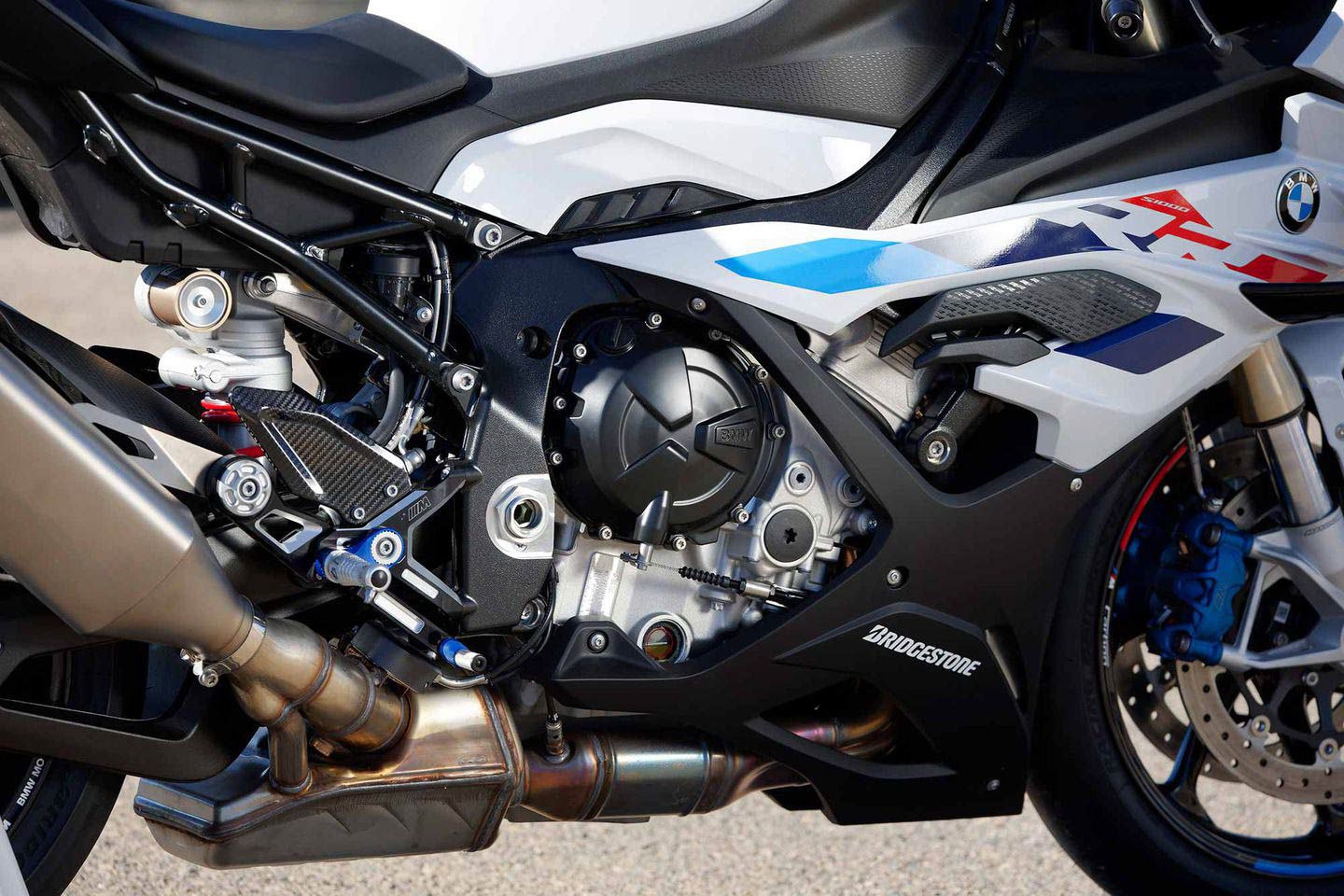
Powertrain: Engine, Transmission, and Performance
The S 1000 RR has a liquid-cooled 999cc inline-four, with DOHC and four valves per cylinder. Bore and stroke measure 80.0 by 49.7mm with the compression ratio measuring 13.3:1. Power is rated at a claimed 205 hp at 13,000 rpm, with 83 lb.-ft. of peak torque coming at 11,000 rpm. Redline is set at 14,600 rpm.
In Cycle World’s 2023 S 1000 RR First Ride, Blake Conner said: “There is no question that the S 1000 RR is a total beast, providing acceleration that only a few production bikes on the planet can match, but at the same time, I was instantly blown away by the bike’s composure.”
It’s true that BMW has struggled to keep US-bound S 1000 RR’s on par with the European variants when it comes to power, and this is certainly something to consider if your focus is on peak horsepower and torque figures. There’s some comfort, however, in knowing what the hardware is capable of.
Chassis/Handling
The well-sorted frame, which is constructed with four gravity die-cast pieces that are welded together and then use the engine as a stressed member, gives the S 1000 RR all of the traits needed for fast laps around the racetrack. Steering is quick (especially when equipped with the ultralightweight carbon wheels), but the bike doesn’t feel knifelike or require extra care as you flick it through a tight section of corners. It’s planted and confidence inspiring, which is all you can expect from a superbike capable of lap-record pace.
Suspension is provided by a 45mm upside-down Marzocchi fork in the front and a linked monoshock of the same make at the rear; both are fully adjustable. The optional Dynamic Damping Control (DDC) is part of the Premium Package. The system takes information from the selected ride mode and determines the ideal compression and rebound settings for the selected choice.
Now more than ever, there is a lot of adjustment in the BMW chassis, and riders who enjoy fine-tuning the setup will appreciate all of the options within the S 1000 RR’s hardware.
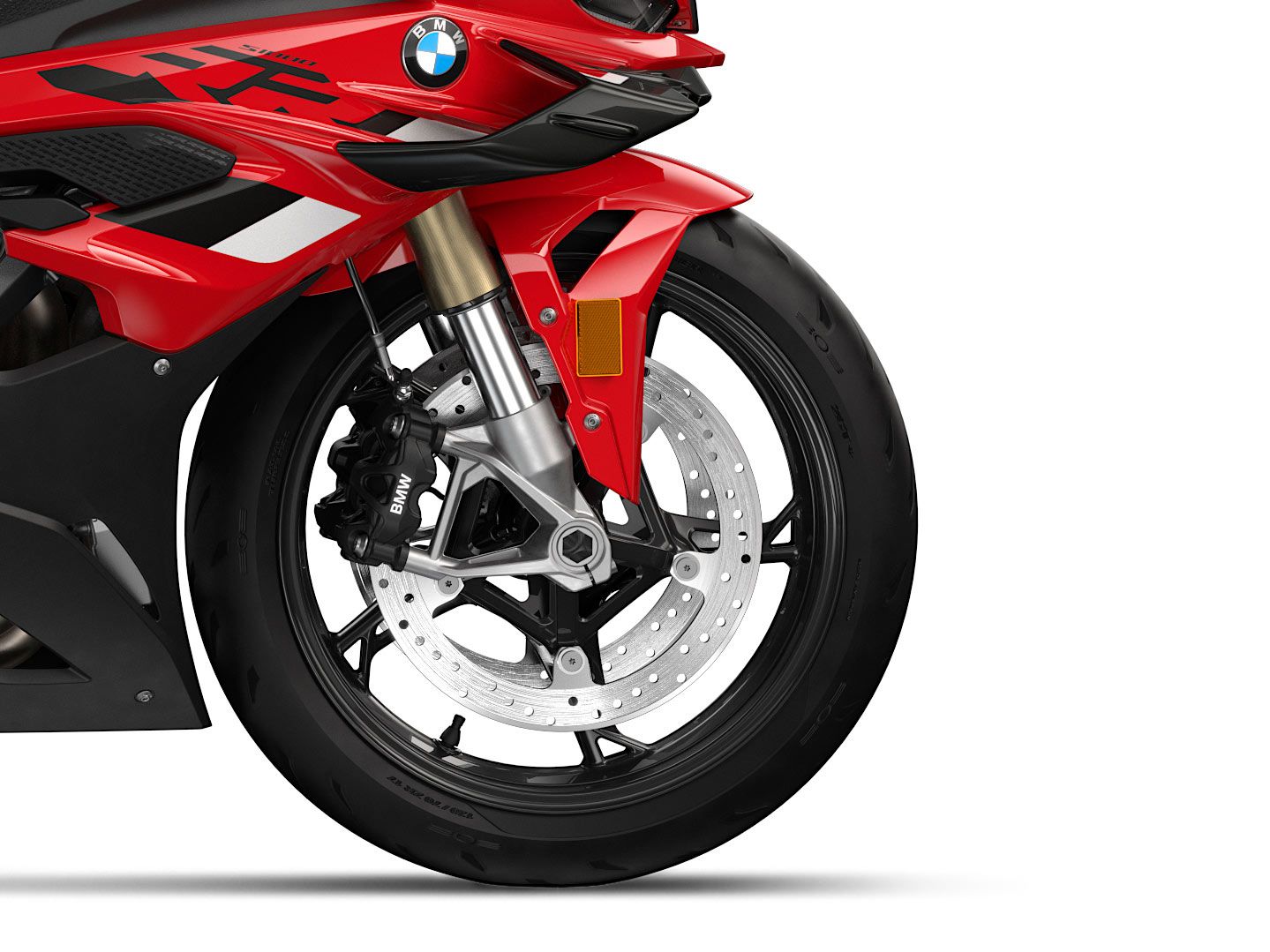
Brakes
The bike uses a pair of radial-mount Nissin four-piston calipers up front biting on 320mm rotors, while a single-piston Brembo caliper and 220mm disc reside out back.
Out on the track and with up-spec ABS Pro Slick mode at work with the front tire squirming on some minor undulations, the bike’s rear end follows in line precisely with the combo of the electronics and slipper clutch working perfectly.
The brakes are a nice balance of aggressive stopping performance and controlled power. They have great bite without the sharp sensation that requires extra focus as you transition to the brakes after a long straightaway. Some may be frustrated with having to upgrade to Ride Modes Pro to access the latest-generation rider-aid software, but doing so really pays off when hitting the track.
Fuel Economy and Real-World MPG
We’ve yet to put the S 1000 RR through our testing routine in the US.
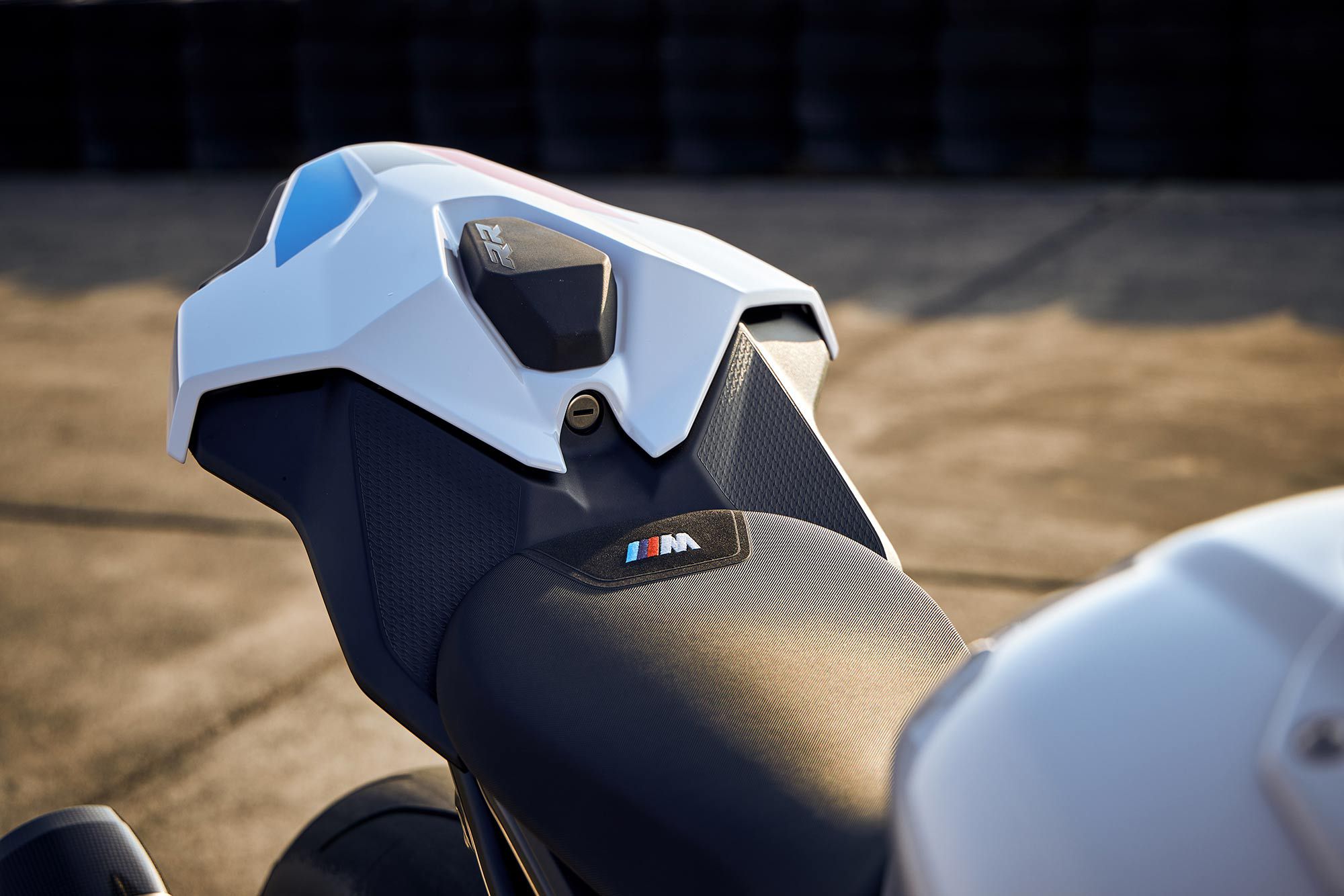
Ergonomics: Comfort and Utility
The S 1000 RR is a full-on track-ready sportbike, so you have to expect that the ergonomics are focused for that task. There are a few options that can help you get more comfortable, including three seat options: a high, low, and standard. You can also opt for BMW’s adjustable M Billet rearsets to further refine your seating position.
Even without the accessories, and considering its racetrack roots, the S 1000 RR is a relatively accommodating motorcycle for most riders. Other superbikes, such as the Ducati Panigale, feel incredibly aggressive from an ergonomics point of view, while the BMW has some room in the seat to move around, and doesn’t put a ton of weight on your wrists.
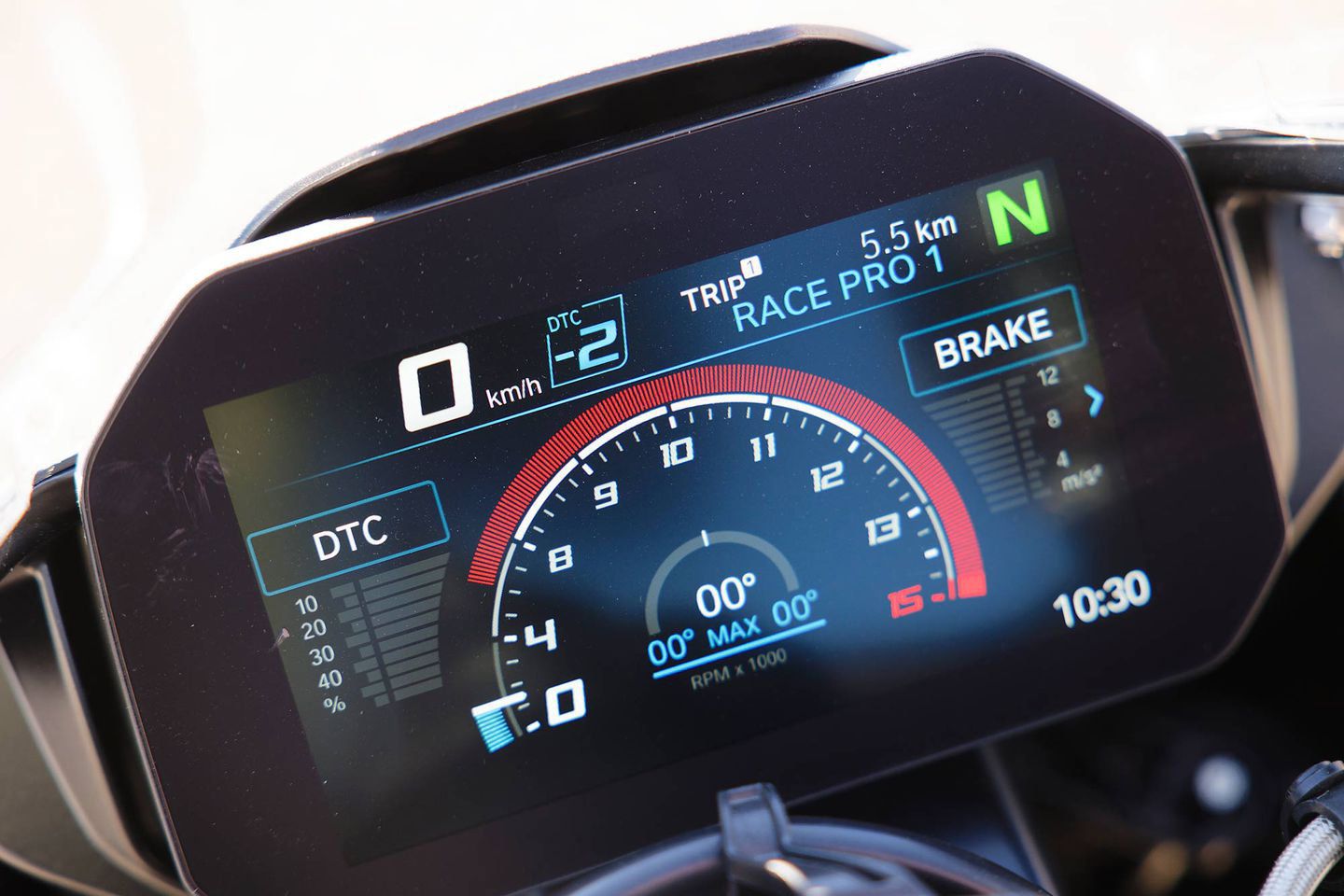
Electronics
Standard features include: BMW Motorrad ABS, ABS Pro, Dynamic Traction Control, Hill Start Control, Gear Shift Assist Pro, ride modes, and Hill Start Control. If the buyer intends to ride on track, there are some additional and new features that are included in the optional Premium Package ($2,340), such as: Ride Modes Pro, Dynamic Damping Control, Pit Lane Limiter, and Launch Control, while heated grips and cruise control are also in the pack.
Within the new Ride Modes Pro tier, extensions were created to further enhance the track rider’s experience. First up is Slide Control that is associated with the DTC system and determines how much the bike can step out while sliding. On the braking side, there are multiple new systems. The first is tied to the engine brake system and called Brake Slide Assist, which allows the rider to step out and slide the rear end of the bike into the corner. There is also a new ABS Pro “Slick” setting, which is part of the Riding Modes Pro option and takes into account the use of slick tires.
The rider interface features a 6.5-inch full color TFT display. All lighting is LED. The optional DDC suspension as mentioned above features damping circuits that are tied to the chosen ride mode.
Warranty and Maintenance Coverage
BMW offers a three-year or 36,000-mile warranty for the S 1000 RR.
Quality
From our firsthand experience, fit and finish on the S 1000 RR is excellent. The extensive three-year warranty only boosts confidence in the machine.
2023 BMW S 1000 RR Specs
| MSRP: | $17,895 (base) |
|---|---|
| Engine: | DOHC, liquid-cooled inline-four; 16 valves |
| Displacement: | 999cc |
| Bore x Stroke: | 80.0 x 49.7mm |
| Compression Ratio: | 13.3:1 |
| Transmission/Final Drive: | 6-speed/chain |
| Claimed Horsepower: | 205.0 hp @ 13,500 rpm |
| Claimed Torque: | 83.0 lb.-ft. @ 11,000 rpm |
| Fuel System: | Electronic fuel injection w/ 48mm throttle bodies |
| Clutch: | Wet, multi-disc back-torque-limiting; cable operation |
| Engine Management/Ignition: | Ride-by-wire/TCI |
| Frame: | Twin-spar aluminum |
| Front Suspension: | 45mm Marzocchi inverted fork, fully adjustable; 4.7 in. travel / DDC |
| Rear Suspension: | Marzocchi shock, fully adjustable; 4.6 in. travel / DDC |
| Front Brake: | Nissin 4-piston Monoblock calipers, dual 320mm discs w/ ABS |
| Rear Brake: | Nissin 1-piston slide-pin caliper, 220mm disc w/ ABS |
| Wheels: Front/Rear: | Cast aluminum; 17 x 3.50 in. / 17 x 6.00 in. / M Carbon Fiber |
| Tires: Front/Rear: | 120/70ZR-17 / 190/55ZR-17 (200/55ZR-17 M wheel) |
| Rake/Trail: | 23.6°/4.0 in. |
| Wheelbase: | 57.3 in. |
| Ground Clearance: | 4.7 in. |
| Seat Height: | 32.8 in. |
| Fuel Capacity: | 4.4 gal. |
| Claimed Wet Weight: | 434 lb. (427 lb. M Package) |
| Contact: | bmwmotorcycles.com |
Source: MotorCyclistOnline.com
